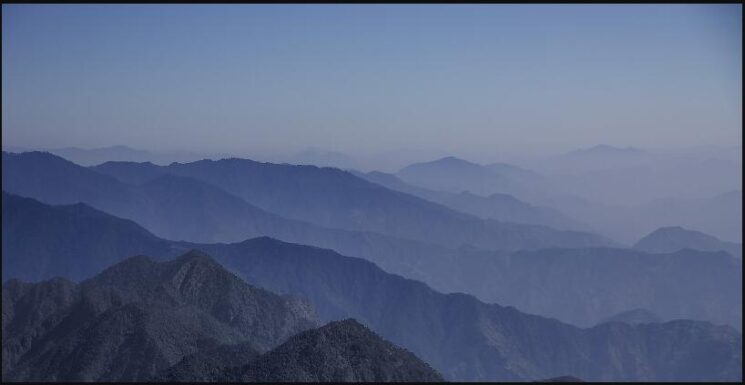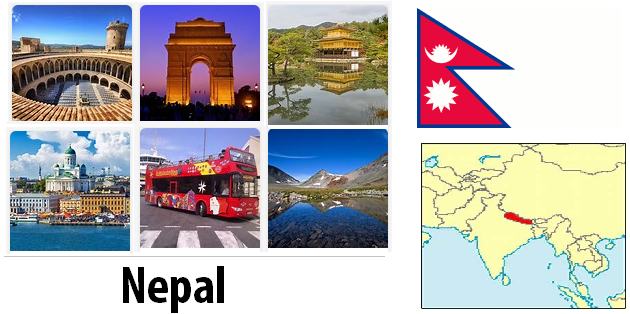Best time to go to Nepal
In any case, keep in mind the climate in your travel plans that if you come at the wrong time, you won’t see the Himalayas. The best time to visit is probably the beginning of the dry season in October / November: the weather is mild, the air is clean, the view is perfect and the landscape is lush green after the monsoons. However, roads and paths in the monsoon have been damaged and can only be repaired after the monsoon.
February to April, at the end of the dry season, is the second best time to travel: the weather is warm and wild flowers are in full bloom in most of the country. However, dust can obscure the view.
In December and January the sky is crystal clear, but it can get cold: trekkers have to prepare well for snow, a warm sleeping bag already pays off in cheaper hotels.
The rest of the year is quite uncomfortable for travel: May and early June are usually too hot and dusty, and the monsoon from mid-June to September covers the mountains with clouds and turns roads into muddy slopes. At this time, flying is often the only way to reach remote regions and the western border crossings to India are often impassable.
Money
Currency: 1 Nepalese rupee corresponds to 100 paise
Currency abbreviation: NPR (ISO code), NR (single), NRs (plural) – ABBREVIATIONFINDER.ORG
Banknotes are in circulation of 1, 2, 5, 10, 20, 50, 100, 500 and 1,000 rupees. Coins are used in amounts of 1, 5, 10, 25 and 50 paise as well as 1, 2, 5 and 10 rupees.
Exchange rate:
October 2009
1 US dollar = 75.6 NPR
1 euro = 111.1 NPR
1 Swiss franc = 73.4 NPR
Sightseeing
Nepal is a country that has a large number of different sights to offer its visitors.
One of the country’s main attractions is the Shingha Durbar, the former Rana Palace. The magnificent palace was completed in 1901 within a year. The palace has seventeen courtyards and more than 1,700 rooms. The palace was considered the largest private residence in Nepal. Unfortunately, not all parts of the complex are present today, since a large fire raged in the palace in 1973. At that time, only the front remained.

The pottery center is also worth a visit. There the artisans sit almost on the street to pursue their craft. Here all pottery is created by hand and massive turntables. This method of production has been passed on in this way for generations. The finished earthenware is placed in the sun to dry. This sight, when the square is littered with thousands of different clay pots, is impressive.
The country also has some natural beauties to offer. So here is the Himalayas. The highest mountains in the world can be seen in this mountain range, including Mount Everest, Nanga Parbat and Makalu. The three mountains are among the most famous on earth.
The Mahendra garden is worth seeing. In this small park there is a huge water tank, which is fed by 22 taps. The copy of the sleeping Vishnus by Budhailakantha is special. The statue is 2.5 meters long. She has her eyes directly on the temple of Shitala Mai, the goddess of smallpox, which stands directly in front of her.
There are other nature reserves that are worth seeing in Nepal, such as the Sagamtha National Park, the Langtang National Park, the Royal Shukla Phanta Wildlife Reserva etc. Nepal is simply a paradise for nature lovers, because there is a unique flora and fauna as well as fantastic natural beauties.
But tourists interested in culture are not neglected in Nepal. These should not be missed under any circumstances called the Maru Stattal or Kashtamandap. The building is a rather inconspicuous building. However, its foundation stone was laid in the fourteenth century. The Kashtamandap is a kind of covered platform, which is still used today, for. B. market or children’s playground, etc. is used.
The huge tundikhel is also worth a visit. Officially, the place was a military parade ground, but it is often used as a cricket or soccer field. There are equestrian statues depicting war heroes on the edges of the tundic.
Other old buildings that should be seen are the Bhimsen Tower, the Shahid Gate, the Mahendrapul, Hetada, Ropeway or Janakpur.
There is a whole list of temples and stupas to visit in Nepal. Almost all of the temples and stupas are worth seeing, because they are all very impressive due to their splendor and interesting architectural style. Don’t miss Dubar Square, Sto-Machhendranath Temple, Chhusya Bahal, Kalmochan Temple, etc.
But there is much more to see in Nepal. The birthplace of Buddha can be seen here. There is also the Mayan Devi Temple, dedicated to his mother. The landscapes around the cities of Bhairawa and Dhankuta are worth seeing, but also the cities themselves.
Even museum lovers are not neglected in Nepal. The Patan Museum in Patan Durbar is definitely worth a look. The museum shows the country’s traditional spiritual and sacred art. Nepal also has a small zoo to show animals from the Himalayan region and the Terai.
The Bhaktapur Art Gallery is also worth seeing. Hindu and Buddhist paintings are exhibited in the gallery, such as thangkas, palm leaf manuscripts and even works of art made of wood, metal and stone.
Other interesting museums in Nepal are the Woodcarving Museum, the Brass and Bronze Museum, the Natural History Museum and the Pokhara Museum.
Kathmandu in Nepal
The main and largest city in Nepal is Kathmandu. It is the center of the densely populated Kathmandu valley and lies between the rivers Vishnumati and Hobi Khola. Kathmandu has around 670,000 inhabitants on an area of 50.67 square kilometers.
According to legend, a goddess told King Gunakama to build the city. This is how Kathmandu originated in 950 AD, right at the confluence of the Vihnumati and Bagmati. At that time the city was still called Contipur. A thriving commercial center was built here. The actual city of Kathmandu was not founded until the fourteenth century.
There are only a few sights to see in the Nepalese capital:
Hanuman Dhoka Durbar
The royal palace dates from the fourteenth century and still serves as the residence of the government today. Unfortunately, an earthquake in 1933 destroyed the more than thirty courtyards enclosed in the palace district.
Patan Central Zoo
The zoo was founded in 1932 and has been fully accessible to visitors since 1956. The absolute highlight is the pond created in the 17th century in the Patan Central Zoo. As a visitor, you can not only see animals from seven hundred species and the diverse, colorful bird life with around a hundred different species, but also take romantic boat trips on the pond.
Ratna Park
This park is the green lung of Kathmandu and on its green spaces everyone can relax and recover from everyday stress.
Mahendra Museum
The museum within the walls of the Hanuman Dhoka Palace holds many treasures from the possession of the King Mahendra
Museum of Natural History
In this museum the visitor learns a lot of interesting facts about the flora and fauna of the country of Nepal.
National Bronze Art Museum
With around nine hundred exhibits, this museum is a worthwhile destination for archeology enthusiasts. For the most part, finds from the Licchiabi period, mostly of religious origin, are exhibited here.
Ashok Binayak
He is the goal of many believers every day to pray to their god Mara Ganesh. It is one of the most important and oldest Ganesh shrines in the entire Kathmandu Valley.
Jagannath Temple
It is one of the oldest temples in Kathmandu and dates from the sixteenth century. The temple, once dedicated to the god Vishnu, was transformed into a Jagannath temple. In this cult, Vishnu is upside down in the form of a billy goat, so it should not be surprising if you see some goats crossing the path when you visit the temple.
